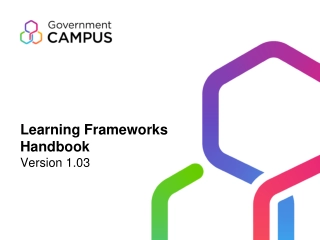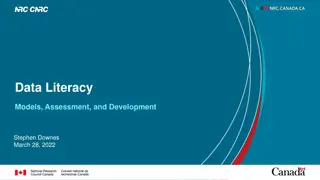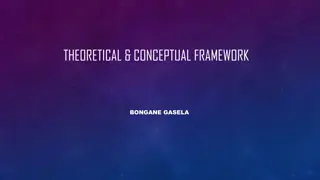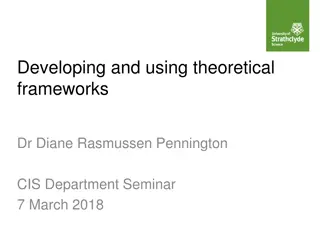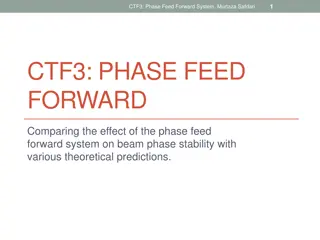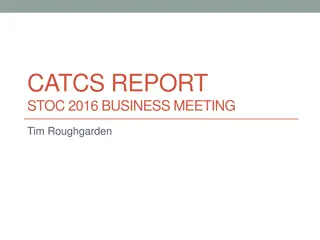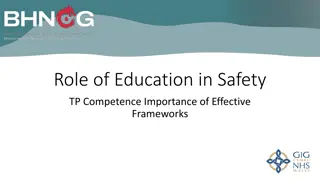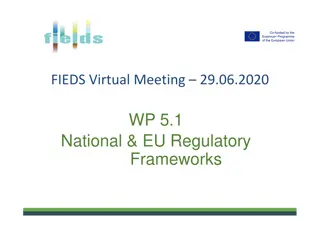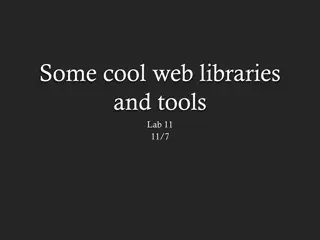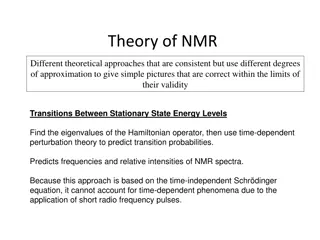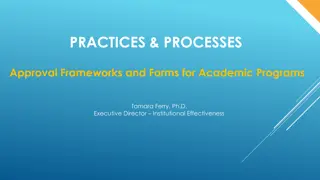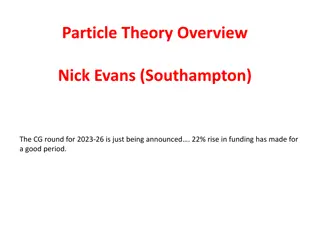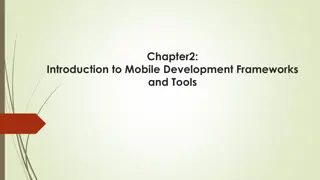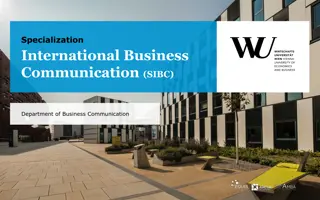Evolution of Development Communication: Theoretical Frameworks and Applications
Exploring the interdisciplinary field of Development Communication, this seminar delves into theoretical frameworks, methodological applications, and practical implications at the World Bank. It reflects on the evolution, theories, and practices underlying Development Communication paradigms, with a focus on the Modernization Paradigm and its heavy emphasis on media influence.
Download Presentation

Please find below an Image/Link to download the presentation.
The content on the website is provided AS IS for your information and personal use only. It may not be sold, licensed, or shared on other websites without obtaining consent from the author. Download presentation by click this link. If you encounter any issues during the download, it is possible that the publisher has removed the file from their server.
E N D
Presentation Transcript
SEMINAR SEMINAR 1 1 DEVELOPMENT COMMUNICATION DEVELOPMENT COMMUNICATION - - METHODOLOGICAL FRAMEWORK AND ITS METHODOLOGICAL FRAMEWORK AND ITS APPLICATIONS APPLICATIONS PRESENTED BY ASWATHY CHANDRAKUMAR PRESENTED BY ASWATHY CHANDRAKUMAR PALB 4112 PALB 4112
OBJECTIVES OBJECTIVES To conceptualise the evolution of interdisciplinary field of Development Communication and provide an overview of the main theoretical frameworks. To study the wide range of methodological and practical applications of Development Communication. To document the way Development Communication is positioned and applied at the World Bank. To review related case studies.
INTRODUCTION INTRODUCTION The term Development Communication was first coined by Nora C. Quebral in 1972. Art and science of human communication linked to a society s planned transformation from a state of poverty to one of dynamic socio- economic growth that makes for greater equity & the larger unfolding of individual potential. Development integration of strategic communication in development projects Communication is the EVERETT ROGERS EVERETT ROGERS FATHER OF DEVELOPMENT COMMUNICATION DEVELOPMENT COMMUNICATION FATHER OF (World Bank)
REFLECTIONS ON THE THEORIES AND PRACTICE OF DEVELOPMENT COMMUNICATION
BRETTON WOODS LATIN AMERICAN INDIAN LOS BANOS AFRICAN PARTICIPATORY
MODERNIZATION MODERNIZATION PARADIGM PARADIGM Central idea modernize underdeveloped countries Communication = dissemination of information and messages aimed at modernizing backward countries and their people. relied heavily on the traditional vertical one-way model:
Heavy emphasis on media owing to the belief that it could change people s mindsets and attitude, when used properly. UNESCO, considered media to be a crucial means promoting change, and in the 1960s, guidelines country s desirable capita consumption television sets, receivers, newspapers, and cinema seats. for example, for Hypodermic Needle Theory it about provided a per of radio
DEPENDENCY AND DEPENDENCY AND WORLD SYSTEMS WORLD SYSTEMS THEORY THEORY Originated in Latin America. A.G. development and underdevelopment as two sides of the same coin. Frank (1969) considered Imbalances in the world s state of affairs were mainly owing to the international division of labor and to the continuation of past patterns of domination.
Uneven flow of media and information from rich countries. At the national level, failed to give proper attention to the potential of privately owned media and community media. Did not consider and support the wider role of freer communication systems Despite significant differences between modernization and dependency theories, their communication model was basically the same: a one way communication flow
PARTICIPATORY PARTICIPATORY PARADIGM PARADIGM Endogenous vision of development Development efforts have been refocused to increasingly engage stakeholders Attention to power and rights issues Emphasis on people New priorities, well beyond the economic dimension, are paid attention to. Participatory paradigm
PASSIVE PARTICIPATION Attend meetings to be informed Mefalopolus identified 4 types of participation (2003) 1. PARTICIPATION BY CONSULTATION Stakeholders are consulted but decision made by experts 2. FUNCTIONAL PARTICIPATION Stakeholders put some input 3. EMPOWERED PARTICIPATION Participation throughout development 4.
THE MULTITRACK COMMUNICATION MODEL Monologic 2 modes of communication Dialogic
BASIC PRINCIPLES OF DEVELOPMENT COMMUNICATION 1. Dialogic relevant stakeholders have their voices heard and that project priorities are aligned with people priorities. 2. Inclusive identifies, defines, hears, and understands relevant stakeholders 3. Heuristic solving problems during the initial phases of a development initiative is essential.
4. Analytical Going beyond communicating 5. Contextual No precooked universal formula applied a priori in development communication 6. Persuasive To induce voluntary changes in individuals.
Results Monitoring & Evaluation Activities implementation Strategy design Communication based assessment (monitoring and evaluation)
Birds eye view of the overall situation is gained. a type of field research It utilizes principles and tools to facilitate dialog, build trust, analyze political risk, and assess conditions to identify entry points for the communication strategy. CBA is always necessary to design an effective communication strategy. Flexible instrument
EFFECTIVE DIALOG FOR SUSTAINABLE CHANGE The value of dialog leading to change can be seen in a visual image known as the Johari Window. Window 1: OPEN KNOWLEDGE What We know and They know Window 3: THEIR HIDDEN KNOWLEDGE What They know and We do not know Developed by Joseph Luft and Harry Ingham Window 2: OUR HIDDEN KNOWLEDGE What We know and They do not know Window 4: THE BLIND SPOT What neither We nor They know Used to map interaction leading to change at a broader level (Anyaegbunam et al. 2004) MOST CRITICAL
1.Become acquainted with key issue STEPS IN CBA STEPS IN CBA 4. Probe problems, causes, risks and opportunities 3. Assess communication networks 2. Build trust 7. Transform best solutions in objectives 5. Assess and rank options and solutions 6. Validate extent of problem
1. 2. 3. Free discussions In depth Semi - structured INTERVIEWS FOCUS GROUP DISCUSSIONS PRCA Tools for CBA BASE - LINE SURVEYS OPINION POLLS SURVEYS
4 SEQUENTIAL STEPS IN PRCA PRCA PRCA to warm up, get to know each other and build trust among stakeholders; Participatory Appraisal was first developed in Africa to promote the use communication in the Southern Africa Development Community (SADC) region. Rural Communication to know the community of participatory better to assess the situation Strong communication issues horizontal connotations in to identify the best options and opportunities that can be addressed communication PRCA can be defined as an empowerment communication research approach, based on dialog through
TOOLS USED IN PRCA 1. Sketch Map 2. Transect Walk 3. Time lines 4. Seasonal Calendars 5. Problem Tree 6. Ranking 7. Livelihood map 8. Venn Diagram
The idiomatic expression jumping the gun (starting a race before the signal to begin) represents one of the most common flaws in the application of communication interventions; that is, a strategy design is analyzing the situation understanding all of the crucial issues and perceptions of the various groups (Anyaegbunam et al. 2004) created without properly and
EXAMPLE EXAMPLE Problem as defined by management Main Causes of the problem Stakeholder s perspective / AKAB Solution / Change needed / objective Deforestation caused by fires Farmers using fires to clear their fields Not sufficiently known. Persuade farmers to stop burning the field Baseline survey conducted No specific intention to burn the forests.
MAIN STEPS OF COMMUNICATION STRATEGY DESIGN BASIC STEP MAIN ACTIVITIES PRACTICAL EXAMPLE 1. Definition of SMART objectives (reviewing focal problem and its causes) Solutions transformed ) into objectives in a Feasible and measurable way Reduction in the incidence of forest lost due to uncontrolled fires by 80% within next two years 2. Definition of primary stakeholders (1SHs and secondary audiences and stakeholders (2SHs Define and probe main groups of interest or audiences, including those indirectly related Local farmers (their cultural ) and socioeconomic context), their families, other ) local actors, NGOs, and to the issues governmental agencies. 3. Definition of type/level of change Define if change is related to awareness, knowledge, attitudes, behaviors, mobilization, collaboration, or mediation For 1SHs: improve knowledge and skills of fire control techniques For 2SHs: raise awareness
4. Define communication approaches or tactics Select communication (linear or interactive mode) the most effective approaches For 1SHs: capacity building, technical training For 2SHs: awareness raising media campaign 5. Select channels or media Select most appropriate media for 1SHs and 2SHs For 1SHs: use preferred sites and venues to provide information For 2SHs: select appropriate media mix in that context 6. content topics Design messages or Define key content message and the most effective way to package them For technical issues For 2SHs: awareness and knowledge 1SHs: instructional design, key messages for raising 7. Expected results once the strategy is carried out Set goal for 1SHs: a change in behaviors to destruction Set goal for 2SHs : raising the awareness 1SHs: adopt more secure techniques to reduce incidence of uncontrolled fires 2SHs: become more aware of the importance or benefits of preserving the forest reduce forest about the
SOCIAL MARKETING strategy, strategy, however, denotes however, denotes the overall design the overall design of the of the communication communication program, which program, which might include one might include one or more or more communication communication approaches and approaches and objectives. objectives. ADVOCACY INFORMATION DISSEMINATION & CAMPAIGNS INFORMATION, EDUCATION, AND COMMUNICATION INSTITUTIONAL STRENGTHENING COMMUNITY MOBILIZATION NONDIRECTIVE PARTICIPATORY COMMUNICATION
Five Management Decisions Five Management Decisions Situation Analysis Framework Logical Analysis Framework
FIVE FIVE MANAGEMENT MANAGEMENT DECISIONS DECISIONS Audience Behaviour Developed by Caba ero-Verzosa, in order to highlight the link between management communication objective. objective and Message Channel Used in monologic / diffusion mode. Evaluation Indicators It addresses five basic communication concepts, closely resembling the Lasswell (1948) five question model : WHO, says WHAT, in WHICH channel, to WHOM, with what EFFECT.
Implement the work plan and to produce and distribute media and information products. Communication Objectives Pretesting the communication material Drawing up the action plan
Communication Communication Tools for Tools for Implementation Implementation Tools used in this phase relate mostly to the specific media selected (for example, print, radio, video), and on the training needed to carry out the successful implementation of the activities. Aware of the potentials of each medium and the criteria for its best utilization
Evaluation can be defined as the process of determining whether, and to what extent, a certain produced the intended result (Babbie 2002). intervention has Formative Evaluation Summative Evaluation
WHAT & HOW WHAT & HOW TO MEASURE TO MEASURE Identify key indicators from the start It is important to consider and to assess if and how external variables have influenced the outcome As stated by Mazzei and Scuppa (2006), communication objectives are either about changing specific knowledge, attitudes, and behaviors or practices in individuals and groups of individuals, or they are about improving the degree of mutual understanding, social and cultural exchange, or the cooperation among different groups of stakeholders, engaging them in the development initiative.
BASICS OF EVALUATION DESIGN BASICS OF EVALUATION DESIGN EXPERIMENTAL DESIGNS QUASI QUASI EXPERIMENTAL EXPERIMENTAL DESIGNS DESIGNS QUALITATIVE RESEARCH DESIGNS 01 01 02 02 03 03 Text Title Text Title Place your own text here 04 04 According to Babbie (2002), the most effective evaluation research is one that combines qualitative and quantitative components.
DEVELOPMENT COMMUNICATION SERVICES AND EXPERIENCES AT THE WORLD BANK
A Division in the External Affairs, Communications and United Nations Affairs Vice-Presidency. clients are Bank operational staff and client country personnel. Capacity to work in 18 languages, programs in 7 languages. Primary delivering
DevComm DevComm Mission Mission To ensure that development interventions incorporate political, social and cultural diagnosis in their design and implementation. To ensure that communications becomes a pillar of development that supports: better development outcomes real political participation in decision making the information base for policy design options an instrument for creating awareness of development priorities
Development Communication Division External Affairs Vice Presidency Scaling up Communications for Operational Results Internal Communicatio n Creating a common platform for messages and programs Communicating what we do and how we do it; building trust in the institution and support for development. Institutional Communicatio n Issue campaigns to accelerate action on key global public goods including at the country level Integrating communications and assessing political and development risks for more effective strategy and design leading to better outcomes Advocacy Communicatio n Development Communicatio n
Communication in Operations DevComm work is organized into three service lines Public Opinion Research Knowledge and Learning
Communication in Communication in Operations Operations Application of communication approaches and methods for behavior and social change in different projects. Communication for Sustainable Development in Operations Unit DevComm is actively involved in more than 100 projects a year in various sectors Communication for Governance and Accountability Program A number of trust-fund donations from donor countries are received to augment its capacity. Partnership Building
CommGAP Training and capacity building Seeks to promote good and accountable governance Research and advocacy Support to operations Good Governance
WOMENs PARTICIPATION IN COMMUNITY RADIO TIMOR LESTE DevComm DevComm- -SDO SDO Created in 2001 with a mandate to mainstream development communication into development projects and programs. DevComm-SDO carrying out the first World Congress on Communication for Development, which took place at FAO headquarters in Rome, on October 25 27, 2006. was instrumental in COMMUNITY RADIO IN KENYA
ANDHRA PRADESH ANDHRA PRADESH RURAL INCLUSIVE RURAL INCLUSIVE GROWTH PROJECT GROWTH PROJECT To enhance agricultural incomes and ensure increased access to services related to health, nutrition, sanitation and social entitlements. Focus on small and marginal farmers, especially from Scheduled Caste (SC) and Scheduled Tribe (ST) Enhance market access for farmer To exploit growth opportunities for high value commodities and significant investments in ICT and mobile-based service delivery systems.
Responsible for partnering with UN agencies, bilateral donors, think tanks, foundations, academia, and other international financial institutions Partnership Buildidng To enhance the use of communication to promote effectiveness programs and projects. in development To produce global public goods in communication that everyone can use
LAUNCH OF LAUNCH OF OpenIndia OpenIndia Lays Group's entire India program in a transparent and easy-to-use manner. out the World Bank Allows the user to learn about the country's challenges and track the World Bank Group's (WBG) programs to address them. development
Public Opinion Public Opinion Research Research 2. o Design, management, and development of polls at a global level as well as opinion research initiatives across the Bank. o Focuses on external constituents clients and other stakeholders. o Client surveys tailored to the needs of the country.
Knowledge and Knowledge and Learning Learning 3. Conduct courses on communication to support lending operations and knowledge products offers workshops. distance-learning courses and operational customized helps Bank staff, governments, and other local partners enhance their capacity to implement and sustain communication activities. this unit is also engaged in collecting, systematizing, and sharing knowledge
DevComm Portfolio by Sectors OctoberFY04 [total = 93 projects] Agriculture and Rural Development Economic Policy Education 8% 0% Energy 18% 2% 3% Environment 1% Finance 9% 1% Health Nutrition and Policy 7% HIV/AIDS Law & Justice 8% 21% Multisector 5% Public Administration 1% 9% 7% Social Protection Transport Water supply and Sanitation Others SOURCE www.worldbank.org
Agriculture and Rural Development Economic Policy & Debt DevComm Portfolio by Sectors JUNE FY06 (Total = 126) Education 1 2 Energy & Mining 2 4 1 3 2 Environment 14 4 Poverty Reduction 2 Health Nutrition and Policy HIV/AIDS 6 6 Law & Justice Multisector Public Sector Governance 9 Social Development 16 Transport 1 Water supply and Sanitation Multisector 13 2 Urban Development 6 1 Infrastructure 9 8 Social Protection 5 Trade PSD FSE CSR SOURCE www.worldbank.org










